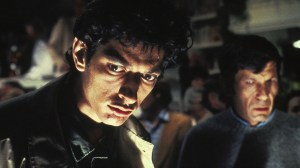
Paper Girls, the new series from the all-star team of Brian K. Vaughan, Cliff Chiang, and Matt Wilson,was released the week of New York Comic Con to widespread critical acclaim. ComicBook.com sat down with Chiang to discuss his development since leaving Wonder Woman, the creation of Paper Girls, and what the future holds for this great new series.
Videos by ComicBook.com
The first issue of Paper Girls is now out in the world. People are reading it and responding to it. So how are you feeling now?
Cliff Chiang: It has been great. The response has been fantastic. One of the things I wanted to do was make sure we were really far ahead so we could figure out what the book was about before people saw it. I didn’t want their opinions to influence me. So I was working in a vacuum for the better part of a year. Now the book is out and it is a great feeling because there has been such a lead up to this moment and it’s finally here.
You’ve only had covers published since Wonder Woman ended, so this is your first comics work in about a year. How has that experience been?
Chiang: I liked it, but it’s a funny thing. You’re sitting at home and it feels like you can see all the other kids outside playing. For me it was all about keeping my head down, working, and knowing that eventually the book would come out.
While there are certainly some comparisons that can be made with your work on Wonder Woman, I think Paper Girls brings a noticeable change in aesthetic and storytelling. What were you focusing on changing during this past year?
Chiang: I think that Paper Girls is not a superhero book changes the expectations. The way in which you make your art look interesting is completely different. For a superhero book I think the audience wants a certain amount of realism in order for the whole thing to be believable, but when you’re working on everyday stuff you can be more stylized because you are drawing stuff like a car and a house. Things need to look cool instead of believing someone can fly.
In that regard it was really liberating to just let go of certain expectations I had because of Wonder Woman. I stopped being hung up on those things and started trying to live up to the legacy of all the great storytellers in comics. There were also those expectations of how she (Wonder Woman) should be drawn and what she should look like. Whereas with this, it’s something we’re just coming up with from whole cloth so we were establishing everything from this first issue.

Do you think Paper Girls creates a good baseline for what the audience should expect in regards to tone and style?
Chiang: I think so. With 40 pages we definitely cover a lot of ground. The book is going to get weirder and it’s kind of on a pendulum. It’s going to get weirder and then it’s going to get less weird, but I think the first issue is emblematic of what kind of book it’s going to be. There are these really human moments, but then you also get these big, fantastic moments.
Just reading the first issue, you not only get a clear sense of what the story is like, but where it is taking place. There are lots of references to the period in dialogue, but when you look at the setting and the fashion, you know when this is. Maybe not that it’s 1988, but definitely the late 80’s. Is most of this pulled from your own experience and memory or has a lot of research gone into creating that sense of place?
Chiang: It was important to me to show something that was believable or authentic for the late 80’s. When people talk about this being an 80’s book, it both is and isn’t. When people talk about stuff that is quintessentially 80’s, they’re mostly talking about stuff from the early 80’s, the Madonna and Michael Jackson kind of stuff. ’88 is different in terms of feel. You’re losing a lot of the big cliches from the early 80’s. For me it was about going through my own memories of the time period, having grown up and been around the girl’s age. What was hot? What were kids doing at that time? The rest was presenting life as it was in the suburbs, which is very different from living in the city.
You and Brian [Vaughan] experienced this all first hand. When creating these pages, what was at the forefront of your mind in communicating what it was like to be there?

Chiang: A lot of what Brian had written in the first issue felt real to me, so it was about how do I capture that and what details can I add to that from the period. It’s different when you’re that age and waking up at 4 or 5 in the morning versus being 30 or 40 and waking up. What is it like to be a kid? What does your room look like? What does your kitchen look like? There are little details throughout that make it feel like a real person’s experience. A lot of it was going over little details in my head and seeing what I could remember, so a lot of my childhood is in the book.
One thing I think you’ve done really well is to not only capture the era, but the age of the girls. They’re at a very difficult point in their life where they’re no longer children, but they also haven’t fully begun adolescence. I think many artists struggle to depict this period of life, but looking at Paper Girls, you know exactly how old these young women are.
Chiang: It was something I was worried about from the beginning. Drawing kids is always a fine balance. You have to make sure they look young, but you can go too far and turn them into Peanuts characters. Then, if you’re actually realistic, 12 and 13 year olds can sometimes look very mature. So I was trying to figure out what reads to the audience as a 12 year old. I think in doing the character designs, I worked a lot of that out. Drawing the first issue with 40 pages also got me into the rhythm of it.
A lot of the maturity you mention comes through in the acting on the page. How they hold and present themselves tells the reader a lot. Mac is obviously very mature for her age –
Chiang: But she’s also one of the shortest too. There’s this whole range. KJ is obviously the tallest. We just wanted to show different body types, heights, and maturity. But they’re all kids and they’re all working through stuff.
That really comes through at the start of the issue when you see Erin wake up and interact with her sister. They barely say a word, but so much about their relationship and maturity can be found there. As Paper Girls continues what are the things you’re most looking forward to depicting, designing, and portraying?
Chiang: I really enjoy working on the book. I’m eager to have people see where we go with it. It does get really weird and we have lots of interesting sci-fi stuff that’s going to happen in the next couple issues. I’m excited for people to see that, but I’m also really invested in the human stuff and that’s something Brian does very well. With each issue, that’s the stuff I just jump into. How do I get the most out of these human moments and balance that with the more fantastic stuff.

You and Matt Wilson had previously collaborated on Wonder Woman and I don’t think there was ever a second choice for the colorist on this book.
Chiang: No.
What has the experience collaborating with Matt been like? I think he really makes the first issue pop and brings this one crazy night to life.
Chiang: He does. It’s something we talked about early on, knowing the way the story takes places all at dawn. It can’t just be a standard way of showing nighttime because then everything would just be blue the whole issue or blue-grey. We realized that we needed to vary our palette, but evoke early morning. I had a certain idea of how I wanted it to look, and it was a great collaborative process.
Chase Magnett is a freelance journalist, critic, and editor working with comics, film, and television. He has been hooked on comics since he picked an issue of Suicide Squad out of a back issue bin fifteen years ago. When Chase is not working with comics in some way he spends his time rooting for the San Francisco 49ers and grilling. He currently contributes to ComicBook.com and other outlets.








